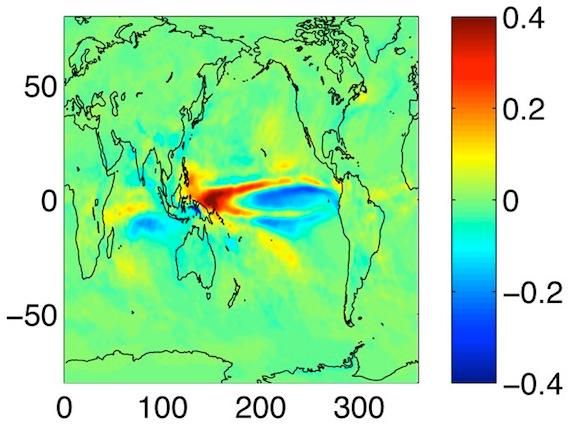New Climate-Shifting Pattern: Is PCO the Next El Niño?
Computer simulations indicate that ocean temperatures and weather patterns might vary on a 100-year-long cycle called PCO
/https://tf-cmsv2-smithsonianmag-media.s3.amazonaws.com/filer/20121002092130PCO-map-small.jpg)
The natural climate pattern El Niño, which involves warming of the Pacific ocean and can cause regional flooding and drought around the world, is fairly well understood by scientists. Because the pattern happens on a roughly five year cycle, researchers can draw upon many different years of data to connect the dots and spot trends.
But if there were similar climate patterns that occurred only every few decades, or every hundred years, how would we know about them? That’s the question that Kris Karnauskas of the Woods Hole Oceanographic Institution and his colleagues were thinking about when they embarked on their latest research project. ”We base many of our conclusions about regional aspects of climate change on instrumental records we’ve obtained over only about 150 years,” Karnauskas told Oceanus. “So we might just be scratching the surface in terms of what is going on naturally over centennial timescales.”
When they put computer models to work evaluating climate patterns in the Pacific over the course of centuries, rather than years or decades, they uncovered a new pattern: Every hundred years or so, as depicted in the map above, water temperatures in certain areas off the west coast of North America and just east of Indonesia increase, while those in other areas near South America, Japan and Australia decrease. The pattern then flip-flops, during what they refer to as the “negative phase” of the cycle, then returns to the “positive phase” once again roughly a century later. Their findings about the pattern, which they call the Pacific Centennial Oscillation, or PCO, were published last week in the Journal of Climate.
To detect these long-term trends, the research team had to rely upon computer model simulations because the sort of data that scientists use to establish shorter-term patterns like El Niño—precise weather temperature readings from ships and satellites—simply aren’t available for events that happened 200 or 300 years ago. Instead, they ran three different climate simulations that factor in the data we do have—recent water temperature readings and parameters of physical processes such as energy and moisture transfer involving land, water, ice and the atmosphere.
All three of the simulations they ran pointed to the existence of this century-long cycle. The researchers also examined the implications of this water temperature pattern on global weather and found a number of likely effects. During the PCO’s “negative phase,” the pool of warmer water in the eastern Pacific off of South America seems to trigger a warming of the atmosphere, altering wind patterns across the Pacific. During the PCO’s “positive phase,” a similar process would likely skew rainfall patterns across the tropics:

These findings may seem abstract, but the effects of El Niño that we’ve observed in the real world are anything but. Scientists have noted that El Niño has likely contributed to more frequent forest fires in Asia, collapses in South Pacific fisheries and decreased agricultural productivity in the United States. PCO is distinct from El Niño, but the global weather pattern could well have effects in these areas as well.
Right now, the team’s findings are purely theoretical. As with theoretical physics, the hypothesis is based upon mathematical calculations, and concrete evidence is needed to confirm whether it corresponds with what we see in the real world.
Fortunately, though, data on ocean temperature trends at this time scale is indeed available. Coral skeletons and other sediments made by oceanic organisms include a chemical signature of the water temperature at the time of their formation; successive layers of these sediments can provide an indication of temperature changes over time. Additionally, areas around the tropics (which should show the most pronounced effects of the PCO) are home to abundant coral reefs made up of these types of sediments.
The researchers hope that their findings will motivate other scientists to collect samples from these reefs and analyze them to see whether the PCO is a real phenomenon—and at what point in the cycle we might be at the moment.
/https://tf-cmsv2-smithsonianmag-media.s3.amazonaws.com/accounts/headshot/joseph-stromberg-240.jpg)
/https://tf-cmsv2-smithsonianmag-media.s3.amazonaws.com/accounts/headshot/joseph-stromberg-240.jpg)